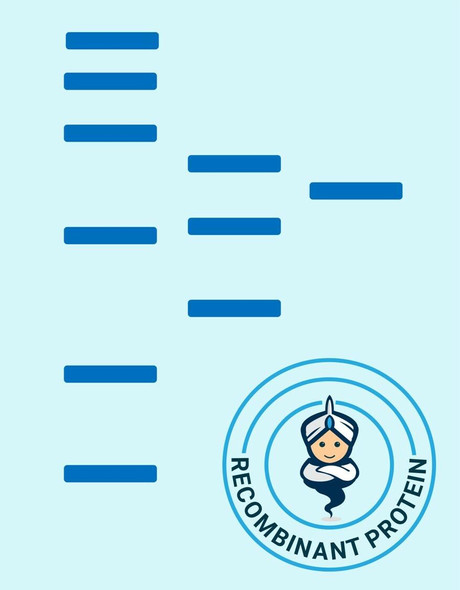Human COMP Recombinant Protein (RPPB3230)
- SKU:
- RPPB3230
- Product type:
- Recombinant Protein
- Size:
- 10ug
- Species:
- Human
- Target:
- COMP
- Synonyms:
- Cartilage Oligomeric Matrix Protein (pseudoachondroplasia epiphyseal dysplasia 1 multiple)
- MED
- THBS5
- TSP5
- Source:
- HEK293 Cells
- Uniprot:
- P49747
Description
| Product Name: | Human COMP Recombinant Protein |
| Product Code: | RPPB3230 |
| Size: | 10µg |
| Species: | Human |
| Target: | COMP |
| Synonyms: | Cartilage Oligomeric Matrix Protein (pseudoachondroplasia epiphyseal dysplasia 1 multiple), MED, THBS5, TSP5, EDM1, PSACH, EPD1, Thrombospondin-5. |
| Source: | HEK293 Cells |
| Formulation: | COMP HEK Human was filtered (0.4µm) and lyophilized from 0.5 mg/ml supplied in 20mM TRIS and 50mM NaCl, pH 7.5 |
| Solubility: | It is recommended to add deionized water to prepare a working stock solution of approximately 0.5mg/ml and let the lyophilized pellet dissolve completely. Product is not sterile! Please filter the product by an appropriate sterile filter before using it on cell culture. |
| Stability: | Store lyophilized COMP HEK Human at -20°C. Aliquot the product after reconstitution to avoid repeated freezing/thawing cycles. Reconstituted COMP HEK can be stored at 4°C for a limited period of time; it does not show any change after two weeks at 4°C. |
| Amino Acid Sequence: | HVDYKDDDDK PAGQGQSPLG SDLGPQMLRE LQETNAALQD VRELLRQQVR EITFLKNTVM ECDACGMQQS VRTGLPSVRP LLHCAPGFCF PGVACIQTES GARCGPCPAG FTGNGSHCTD VNECNAHPCF PRVRCINTSP GFRCEACPPG YSGPTHQGVG LAFAKANKQV CTDINECETG QHNCVPNSVC INTRGSFQCG PCQPGFVGDQ ASGCQRRAQR FCPDGSPSEC HEHADCVLER DGSRSCVCAV GWAGNGILCG RDTDLDGFPD EKLRCPERQC RKDNCVTVPN SGQEDVDRDG IGDACDPDAD GDGVPNEKDN CPLVRNPDQR NTDEDKWGDA CDNCRSQKND DQKDTDQDGR GDACDDDIDG DRIRNQADNC PRVPNSDQKD SDGDGIGDAC DNCPQKSNPD QADVDHDFVG DACDSDQDQD GDGHQDSRDN CPTVPNSAQE DSDHDGQGDA CDDDDDNDGV PDSRDNCRLV PNPGQEDADR DGVGDVCQDD FDADKVVDKI DVCPENAEVT LTDFRAFQTV VLDPEGDAQI DPNWVVLNQG REIVQTMNSD PGLAVGYTAF NGVDFEGTFH VNTVTDDDYA GFIFGYQDSS SFYVVMWKQM EQTYWQANPF RAVAEPGIQL KAVKSSTGPG EQLRNALWHT GDTESQVRLL WKDPRNVGWK DKKSYRWFLQ HRPQVGYIRV RFYEGPELVA DSNVVLDTTM RGGRLGVFCF SQENIIWANL RYRCNDTIPE DYETHQLRQA |
COMP is a non-collagenous glycoprotein and is belongs to the thrombospondin family of extracellular proteins. COMP is a calcium-binding protein of high molecular weight (>500kDa) found in the extracellular matrix of articular, nasal and tracheal cartilage. COMP is not only cartilage-derived but is common in other tissues, such as synovium and tendon. Intact COMP is pentameric, with five equal subunits and the carboxy-terminal globular domain of native COMP binds to collagens I, II, and IX. COMP molecules are vital for conserving the properties and integrity of collagen network. Moreover COMP has a storage and delivery function for hydrophobic cellsignaling molecules such as vitamin D. Mutations of the COMP gene cause Pseudoachondroplasia and some forms of multiple epiphyseal dysplasia which implicates that it is vital that COMP develops and functions normally. It is a well-known fact that serum levels of COMP offer essential data about metabolic changes taking place in the cartil
COMP HEK Protein is a 82.4 kDa protein containing 750 aa fused to a 13 aa N-Terminal FLAG-tag.
| UniProt Protein Function: | COMP: May play a role in the structural integrity of cartilage via its interaction with other extracellular matrix proteins such as the collagens and fibronectin. Can mediate the interaction of chondrocytes with the cartilage extracellular matrix through interaction with cell surface integrin receptors. Could play a role in the pathogenesis of osteoarthritis. Potent suppressor of apoptosis in both primary chondrocytes and transformed cells. Suppresses apoptosis by blocking the activation of caspase-3 and by inducing the IAP family of survival proteins (BIRC3, BIRC2, BIRC5 and XIAP). Essential for maintaining a vascular smooth muscle cells (VSMCs) contractile/differentiated phenotype under physiological and pathological stimuli. Maintains this phenotype of VSMCs by interacting with ITGA7. Defects in COMP are the cause of multiple epiphyseal dysplasia type 1 (EDM1). EDM is a generalized skeletal dysplasia associated with significant morbidity. Joint pain, joint deformity, waddling gait, and short stature are the main clinical signs and symptoms. EDM is broadly categorized into the more severe Fairbank and the milder Ribbing types. Defects in COMP are the cause of pseudoachondroplasia (PSACH). PSAC is a dominantly inherited chondrodysplasia characterized by short stature and early-onset osteoarthrosis. PSACH is more severe than EDM1 and is recognized in early childhood. Belongs to the thrombospondin family. |
| UniProt Protein Details: | Protein type:Secreted; Secreted, signal peptide Chromosomal Location of Human Ortholog: 19p13.1 Cellular Component: extracellular matrix; extracellular space; proteinaceous extracellular matrix; extracellular region Molecular Function:heparin binding; heparan sulfate proteoglycan binding; collagen binding; protein binding; protease binding; extracellular matrix structural constituent; calcium ion binding Biological Process: limb development; organ morphogenesis; extracellular matrix organization and biogenesis; apoptosis; cell adhesion; skeletal development; negative regulation of apoptosis Disease: Pseudoachondroplasia; Epiphyseal Dysplasia, Multiple, 1 |
| NCBI Summary: | The protein encoded by this gene is a noncollagenous extracellular matrix (ECM) protein. It consists of five identical glycoprotein subunits, each with EGF-like and calcium-binding (thrombospondin-like) domains. Oligomerization results from formation of a five-stranded coiled coil and disulfides. Binding to other ECM proteins such as collagen appears to depend on divalent cations. Mutations can cause the osteochondrodysplasias pseudochondroplasia (PSACH) and multiple epiphyseal dysplasia (MED). [provided by RefSeq, Jul 2008] |
| UniProt Code: | P49747 |
| NCBI GenInfo Identifier: | 209572601 |
| NCBI Gene ID: | 1311 |
| NCBI Accession: | P49747.2 |
| UniProt Secondary Accession: | P49747,O14592, Q16388, Q16389, Q2NL86, Q8N4T2, B4DKJ3 |
| UniProt Related Accession: | P49747 |
| Molecular Weight: | 77,214 Da |
| NCBI Full Name: | Cartilage oligomeric matrix protein |
| NCBI Synonym Full Names: | cartilage oligomeric matrix protein |
| NCBI Official Symbol: | COMP |
| NCBI Official Synonym Symbols: | MED; EDM1; EPD1; PSACH; THBS5 |
| NCBI Protein Information: | cartilage oligomeric matrix protein; TSP5; thrombospondin-5; pseudoachondroplasia (epiphyseal dysplasia 1, multiple); cartilage oligomeric matrix protein(pseudoachondroplasia, epiphyseal dysplasia 1, multiple); cartilage oligomeric matrix protein (pseudoachondroplasia, epiphyseal dysplasia 1, multiple) |
| UniProt Protein Name: | Cartilage oligomeric matrix protein |
| UniProt Synonym Protein Names: | Thrombospondin-5; TSP5 |
| Protein Family: | Complexin |
| UniProt Gene Name: | COMP |
| UniProt Entry Name: | COMP_HUMAN |










